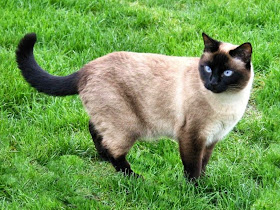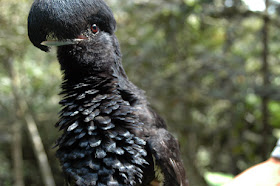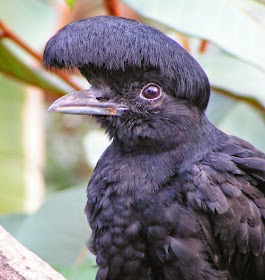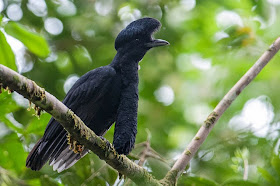Fulgorid are the largest of the planthoppers. They are characterized by wavy, filamentous tails and elaborate head protuberances.
Wednesday, December 31, 2014
Darwin's Frog
Darwin's Frog is named after Charles Darwin who came across it on his famous "Voyage of the Beagle". Darwin's frogs can be found inhabiting beech-tree forests and fields, in the cooler regions of South America.
Clouded Leopard
Clouded Leopard is the smallest of the world's big cats and despite it's name, it is not actually that closely related to Leopards and is instead believed by many to be an evolutionary link between big cats and small cats. Clouded Leopards are incredibly shy animals and coupled with their highly nocturnal lifestyle has meant that little is known about their behaviour in the wild as they are very rarely seen.
Tuesday, December 30, 2014
Flower Loving Fly
Flower Loving Fly is one of the largest flies in the world. Hovering like hummingbirds, flower-loving flies use their long, tubular proboscis (a flexible feeding tube that is an extension of the mouth) to extract nectar from the flowers of native plants.
Unicorn Fish
Unicorn Fish roam in groups feeding on algae. They are closely related to tangs and surgeonfish. The horn-like appendage between their eyes begins growing when a young fish reaches about 13 cm (5 in) in length, and tends to be a little bigger on males.
Black Swallowtail Caterpillar
Black Swallowtail Caterpillar have a special gland that secretes bad-smelling and bad-tasting chemicals to help keep predators away. They molt, or shed their skin, five times. Their coloration and appearance change dramatically as they grow.
Monday, December 29, 2014
Pied Tamarin
Pied Tamarin is an endangered species and is one of the larger species of tamarin found on the South American continent. The pied tamarin is found in only one restricted area in the Brazilian Amazon rainforest, where the pied tamarins are being protected from being hunted and poached in the forest or from being subjected to habitat loss in the form deforestation.
Patas Monkey
Patas Monkey has a long and slimly built body covered in shaggy fur, which is white in colour on the underside and red on the back. Their long and powerful limbs are also white while their face is dark with a white moustache and beard, and a red cap with a heavy brow ridge that protects their eyes.
Cardinal
Cardinal is the only red bird in eastern North America with a crest on top of his or her head, which rises when the bird senses danger.
Siamese
The Siamese cat is one of the oldest breeds of cat, thought to have originated from the Siamese temple cats in today's Thailand (then known as Siam). The Siamese cat has similar features to the Birman cat, another ancient oriental temple cat from Myanmar (Burma).
The Siamese cat is one of the most popular breeds of exotic domestic cat in both Europe and North America today. The breeding of the Siamese cat flourished during the 1900s, when they were introduced to households from south east Asia.
The Siamese cat lives to an average of 8 to 10 years in the wild but commonly live to 15 years old when looked after well as a pet. It is not uncommon for the Siamese cat to reach 20 years old, although the Siamese breed is known to be prone to certain illnesses and conditions.
The Siamese cat is a very affectionate and loyal breed of domestic cat, with the Siamese cat usually preferring human company over anything else including other cats and animals. The Siamese breed is known to be very depend on their human families.
Siamese cats are intelligent animals and can be taught very easily. They can even be taught tricks such as sit, beg, lay down and to walk on a leash. They are also extremely jealous pets ad would not be pleased with you if you brought home another animal. They would become quite destructive to get as much attention possible.
Umbrellabird
Umbrellabird Classification and Evolution
The Umbrellabird is a large, tropical species of bird that is found inhabiting the rainforests of Central and South America. There are three different species of Umbrellabird which are the Long-Wattled Umbrellabird, the Amazonian Umbrellabird and the Bare-Necked Umbrellabird all of which live in slightly different areas. All three species are relatively similar in appearance with an umbrella-like crest on the top of their heads (for which they were named) and a pendant-shaped inflatable pouch on their throats. They are the largest species of perching bird (Passerine) in South America but populations are currently falling mainly due to habitat loss.
Umbrellabird Anatomy and Appearance
The most distinctive feature of the Umbrellabird is the large crest on the top of it's head. During mating, the males fan their crest out so that it nearly covers the whole of their head and they then begin to make rumbling sounds to attract a female. The long, curved feathers are then retracted, making the Umbrellabird more discreet the rest of the time. All three Umbrellabird species are similar in size and have coarse black feathers covering their bodies, but each subspecies does have it's own fingerprint. The Long-Wattled Umbrellabird has a wattle on it's throat that can grow up to 35cm long; the Amazonian Umbrellabird tends to be entirely black and the males are thought to be the largest of all three species; the Bare-Necked Umbrellabird is easily distinguished by the reddish, featherless patch of skin on it's throat.
Umbrellabird Distribution and Habitat
The Umbrellabird is found throughout the sub-tropical belt of Central and South America where they spend the majority of their time hopping between branches high up in the tree canopy. For most of the year, the Umbrellabird can be found inhabiting lowlands and mountain foothills, generally at altitudes less than 500 meters. During the breeding season however, they migrate higher into the mountains where the gather in groups known as a "Lek" where they can find a mate. These breeding sites are usually in cloud forests that are between 800 - 2,000 meters above sea level. The Umbrellabird is known as an altitudinal migrant as it migrates up and down the mountains rather than across the land.
Umbrellabird Behaviour and Lifestyle
The Umbrellabird is generally a solitary animal that is known to co-inhabit areas with other birds including other Umbrellabirds, and similar species such as Woodpeckers. Their large size does make flying more difficult for the Umbrellabird compared to other species meaning that it tends to hop from branch to branch, gripping with it's clawed toes. Although the Umbrellabird can indeed fly short distances, they tend to be relatively slow and clunky in the air. During the breeding season however, they migrate to higher altitudes where they gather in small groups so that they can choose a mate. Here the males perform courtship displays for the females to watch before they pick a partner.
Umbrellabird Reproduction and Life Cycles
Display territories tend to be occupied from March until June, and once having paired up, the female constructs a relatively large nest from twigs, moss and leaves inside a tree that is often far from the ground. This is thought to be to protect the nest from hungry predators that feed on the eggs of the Umbrellabird. The female then lays a single egg which is incubated for only a month before it hatches, with the chick then being fed by it's parents before it leaves the nest a couple of months later. Abandoned nests have been found alongside the current nest indicating that females may even return to the same tree to lay their egg every year. Umbrellabirds are thought to live for an average of 16 years in the wild.
Umbrellabird Diet and Prey
Like many of the world's tropical perching birds, the Umbrellabird is an omnivorous animal that feeds on the feasts high in the tops of the trees. Fruits and small animals are the Umbrellabird's primary sources of food, eating a range of invertebrates such as insects and spiders, along with small frogs and birds. The Umbrellabird uses it's strong toes to hold onto the branches whilst it picks fruits and berries with it's curved beak. The quite long, black beak of the Umbrellabird is similar to that of a Raven and allows the Umbrellabird to snap up passing insects with ease. The Umbrellabird plays a vital role in their native eco-system as they distribute the seeds from the fruits that they eat across the forest.
Umbrellabird Predators and Threats
The Umbrellabird spends the majority of it's time at the tops of trees so ground-dwelling predators pose little threat to this unique bird. Arboreal animals however, are a different story often preying on the eggs and younger individuals that are a more manageable size. Monkeys and Snakes are the primarily predators of the Umbrellabird, along with large Birds Of Prey such as Hawks and Eagles, that are able to hunt from the air. The biggest threat to the Umbrellabird however is Humans, who clear their native lowland forests, generally for agriculture. Although all three species are being severely affected by habitat loss, the Long-Wattled Umbrellabird is thought to be most under threat as it lives in only a handful of very specific areas.
Umbrellabird Interesting Facts and Features
The distinctive throat pouch of the Umbrellabird inflates on the males during the breeding season. The reason for this is because it is thought to make their rumbling calls louder, making a booming sound that is said to sound like a Hippo. The wattle is one of the characteristics that differs the most between the three species of Umbrellabird. The Long-Wattled Umbrellabird has long black wattle (as it's name suggests), where the Amazonian's is shorter, and the Bare-Necked Umbrellabird's is red in colour and much smaller than the others. The Umbrellabird was discovered by Sir Alfred Wallace, a companion of Charles Darwin's, in the 1800s whilst on an expedition to South America.
Umbrellabird Relationship with Humans
Due to the fact that the Umbrellabird lives high in the rainforest canopy and is rarely seen in open areas, it can often be hard to spot during the non-breeding season when it is in the lowlands. Higher up in the mountain cloud forests however, the breeding sites of the Umbrellabird have been known to be targeted by local hunters. It is the deforestation of the lowlands where they spend most of their time however, that has led to drastic declines in their population numbers. These areas are most commonly turned into pineapple and banana plantations that do not accomodate their arboreal lifestyle.
Umbrellabird Conservation Status and Life Today
Today, both the Long-Wattled Umbrellabird and the Bare-Necked Umbrellabird are considered to be Threatened species, where the Amazonian Umbrellabird has been classified by the IUCN as Least Concern. All three species are under threat, mainly due to the loss of significant chunks of their natural habitats, with most of the remaining populations now found in protected areas.





















%2BTaveuni%2C%2BFiji%2B4760.jpg)




























